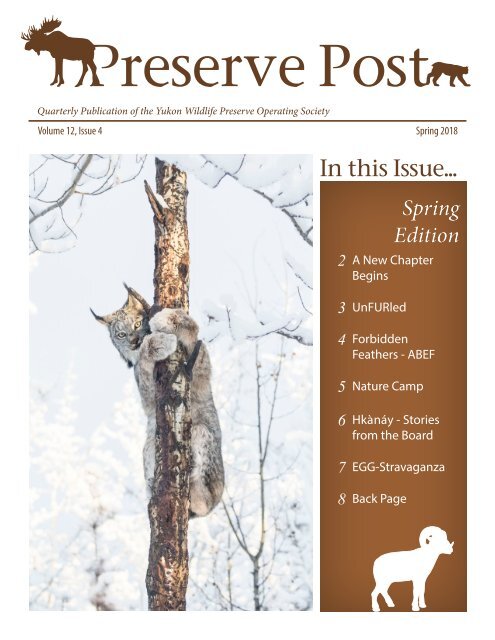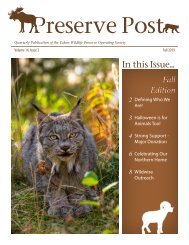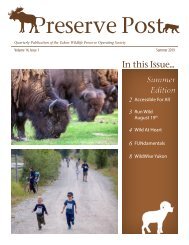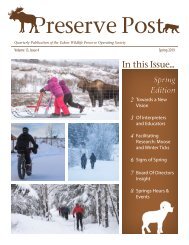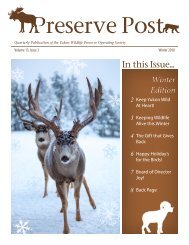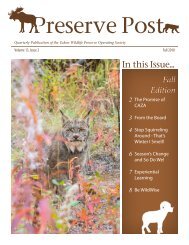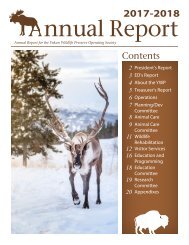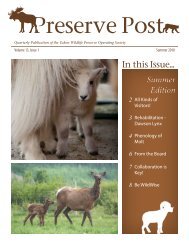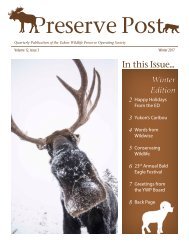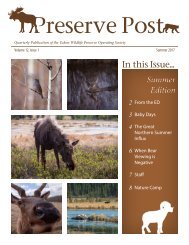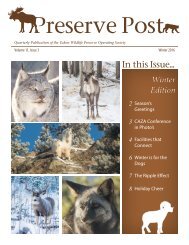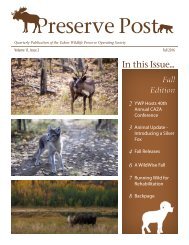2018 SPRING Newsletter
The Preserve Post for Spring 2018 is here! Engage and learn about wildlife from the perspectives of the American Bald Eagle Foundation, from a First Nations Elder, and from those behind the celebration of Yukon's trapping history - UnFURled, and more!
The Preserve Post for Spring 2018 is here! Engage and learn about wildlife from the perspectives of the American Bald Eagle Foundation, from a First Nations Elder, and from those behind the celebration of Yukon's trapping history - UnFURled, and more!
You also want an ePaper? Increase the reach of your titles
YUMPU automatically turns print PDFs into web optimized ePapers that Google loves.
Quarterly Publication of the Yukon Wildlife Preserve Operating Society<br />
Volume 12, Issue 4<br />
Spring <strong>2018</strong><br />
In this Issue...<br />
2 A New Chapter<br />
Begins<br />
3 UnFURled<br />
4 Forbidden<br />
Feathers - ABEF<br />
5 Nature Camp<br />
6 Hkànáy - Stories<br />
from the Board<br />
7 EGG-Stravaganza<br />
8 Back Page<br />
Spring<br />
Edition
A New Chapter Begins<br />
Nearly 14 years ago, the Yukon Game Farm became<br />
the Yukon Wildlife Preserve. This new chapter<br />
saw the Preserve grow. We added new species. We<br />
built visitor infrastructure like interpretive panels,<br />
viewing platforms and a learning centre. We gained<br />
accreditation with Canada’s Accredited Zoos and<br />
Aquariums. And we built an incredible animal care<br />
facility. All this was only possible with the support of<br />
our partners and our community.<br />
For example, the Department of Environment has<br />
enabled us to care for the needs of more than 175<br />
animals. They are the foundation of the Preserve’s<br />
operation. On this foundation, your visits, volunteer<br />
hours, donations and letters of support have made all<br />
the difference.<br />
Consider this: this<br />
year the Preserve will<br />
welcome more than<br />
12,000 Yukoners. Many<br />
of you will be showing<br />
your visiting friends and<br />
relatives around. And by<br />
the end of our fiscal year<br />
(March 31st) we’ll have<br />
seen 30,000 visitors walk<br />
through the front door.<br />
We’re here thanks to your<br />
support.<br />
Now, we are about<br />
to embark on a new<br />
chapter. We don’t know<br />
the nuances yet. (We are<br />
working on securing funding to create a master-plan<br />
that will guide our next 10-years.)<br />
But we know a few things. We know that we want to<br />
find ways to enrich your lives and our community.<br />
We know that wildlife rehabilitation and conservation<br />
based educational programming are critical parts of<br />
what we do. And we know that we need your support<br />
more than ever.<br />
Here’s a few things you can do to help:<br />
• Visit: keep visiting and talk up the Preserve<br />
with your friends and family!<br />
• Donate: its easy and you get a tax receipt<br />
(https://www.canadahelps.org/en/charities/yukonwildlife-preserve-operating-society).<br />
• Volunteer: we need help with fundraising and<br />
sponsorship (send me an email at jake@yukonwildlife.<br />
ca to get involved)!<br />
We are so grateful for all the support we’ve received<br />
over the years. It motivates us to keep looking ahead<br />
and reflecting on how to be the best we can be for you<br />
and our community.<br />
My thanks,<br />
Jake Paleczny<br />
Acting Executive Director,<br />
Yukon Wildlife Preserve<br />
Cover photo: Juvenile female lynx enjoys some time in the trees.<br />
Maybe she’s searching for signs of spring!<br />
2<br />
Above: Jake Paleczny has been a part of the YWP team since December 2012.<br />
Formerly the Director of Education and Programming, he is a member of the<br />
dedicated staff looking to, with support from colleagues, board, partners and the<br />
community, propel the Wildlife Preserve into a new era.<br />
Volume 12, Issue 4
There are a lot of people who live on the land in Yukon. Some of these people are trappers.<br />
When we think about trapping, we might picture a trapper that we know. If we don’t know a trapper personally,<br />
we might think of historical images we have seen, or images in the media that we have come across.<br />
In 2016 and 2017, we asked Yukon trappers what they would like Yukoners to know about trapping. The<br />
responses we received included sentiments like:<br />
• The trapline is essential to the connection of the land and community<br />
• It is the foundation for family values, camaraderie and shared knowledge over generations<br />
• It is a sustainable industry that continues to evolve within the Yukon<br />
UnFURled is a free event for Yukoner’s who are interested in our local fur industry. This free and family-friendly<br />
celebration includes exhibitions, crafting tables, a Fur Boutique (to finally get those mittens or slippers), a Story<br />
Tent, fur101 demonstrations, workshops, a photo-booth and more!<br />
Your very own Yukon Wildlife Preserve has teamed-up with the Yukon Beringia Interpretive Centre to lead some<br />
activities on adaptation and a fur-matching game in English, French or German.<br />
Come along and celebrate with us!<br />
“Trapping is an essential part of our community, our culture and our local economy. We want all Yukoners to be<br />
proud to wear local fur and for everyone to have their own Yukon fur story”<br />
– Jason Van Fleet, Executive Director North Yukon Renewable Resource Council<br />
“We want to increase direct fur sales for local trappers. By selling furs locally, we keep more money in the<br />
territory which is good for the trappers and anyone wanting to buy quality, ethically harvested fur.”<br />
– Brian Melanson, President, Yukon Trappers Association<br />
UnFURled:<br />
Saturday 10 March <strong>2018</strong><br />
9:00 am – 4:00 pm<br />
Kwanlin Dün Cultural Centre<br />
Wild Lives (exhibition launch):<br />
Thursday 8 March <strong>2018</strong><br />
5:00 pm – 9:00 pm<br />
Kwanlin Dün Cultural Centre<br />
Angry Inuk (film screening):<br />
Thursday 8 March <strong>2018</strong><br />
5:00 pm – 9:00 pm<br />
Kwanlin Dün Cultural Centre<br />
Proudly brought<br />
to you by:<br />
http://imfurreal.com/<br />
Spring <strong>2018</strong><br />
3
Forbidden Feathers<br />
Working with three beautiful<br />
bald eagles, I am often asked by<br />
guests to the American Bald Eagle<br />
Foundation “can I have one of those<br />
feathers?” I can’t blame folks for<br />
asking- eagle feathers are incredible<br />
in size and appearance, but the<br />
short answer is no. Bald and golden<br />
eagles are federally protected in<br />
the United States by the Bald and<br />
Golden Eagle Protection Act. These<br />
protections prevent citizens from<br />
possessing any part or product of<br />
these species, and were put in place<br />
to prevent poaching.<br />
People are often shocked by the<br />
idea that anyone would willingly<br />
kill an eagle but poaching for<br />
parts is something that still<br />
occurs today. This inevitably<br />
leads to the next question: “what<br />
do you do with their feathers?”<br />
Each of the eagles we work with<br />
sheds her feathers once a year in<br />
a process called molting. Older<br />
feathers that may be worn or<br />
damaged are dropped, just a few<br />
at a time, and new ones grow<br />
in their place. When we find a<br />
molted feather, we are required<br />
by law to collect it and send it to<br />
the National Eagle Repository<br />
in Colorado. The Repository<br />
is responsible for collecting,<br />
cataloguing, and in some cases,<br />
distributing bald and golden<br />
eagle parts.<br />
But wait, I thought people<br />
couldn’t have feathers? The<br />
long answer is: some people<br />
can have them. The Repository<br />
distributes eagle parts to Native<br />
Americans and Alaska Natives<br />
who are registered members of<br />
recognized tribes and apply for<br />
the proper permits. These parts<br />
have been used for generations in<br />
religious and cultural ceremonies.<br />
In recognition of their cultural<br />
importance, US Fish and Wildlife<br />
makes eagle parts available to<br />
those indigenous people who<br />
request them.<br />
I am sometimes met with<br />
frustration when I explain this<br />
to guests. We’ve all come across<br />
a pretty feather in the woods and<br />
wanted to keep it. Unfortunately,<br />
there are those who take advantage<br />
of wildlife and use it irresponsibly.<br />
Our job, as lovers of wildlife, is to<br />
ensure that there are ways to find<br />
and discourage these people; that’s<br />
where regulations like the Bald<br />
and Golden Eagle Protection Act<br />
or the Migratory Bird Treaty Act<br />
come in. I encourage people who<br />
4<br />
Above Left: Vega is at least 26 years old. She was deemed non-releasable after<br />
an amputation following a vehicle strike. She was an adult when she went into<br />
rehab which is why American Bald Eagle Foundation (ABEF) is uncertain her<br />
exact age. ABEF has been working with Vega since 2015. Above Right: Bella is<br />
estimated to be seven years old, and she works as an educator with ABEF after<br />
being deemed non-releaseable due to an amputation following a power line<br />
interaction. She’s been with the ABEF since 2013.<br />
Volume 12, Issue 4
find feathers or parts to leave them<br />
alone so they are not mistaken<br />
for someone who acquired them<br />
illegally, allowing us to target only<br />
those who are harming wildlife<br />
or bolstering the illegal trade of<br />
wildlife parts. At the same time,<br />
it is important to encourage those<br />
who collect products legally and<br />
sustainably to continue doing so.<br />
Animals are an important<br />
part of human history and<br />
culture. At the<br />
American Bald Eagle<br />
Foundation, we are proud<br />
to contribute to the<br />
Repository and to be a<br />
part ofS the sustainable,<br />
responsible use of animal<br />
parts.<br />
Sidney Campbell is the Education and<br />
Outreach Coordinator at the<br />
American Bald Eagle Foundation in<br />
Haines, Alaska. She works to bring<br />
empowering wildlife education to Haines<br />
and surrounding communities and<br />
worldly visitors by managing outreach,<br />
publications, and educational<br />
programming. She works with the Raptor<br />
Program Manager to train the avian ambassadors at the facility to take part in education and outreach. Visit the<br />
American Bald Eagle Foundation in Haines, Alaska. The facility is currently open Monday to Friday’s 10am - 3pm.<br />
Closed Saturday and Sundays. Explore further online https://baldeagles.org/<br />
Nature Camp<br />
Week-long day camps designed to connect youth with Yukon’s incredible wildlife and landscapes!<br />
4 themes / 9 weeks / Unforgetable fun!<br />
Spaces are filling fast, with some camps already full - to register, visit: yukonwildlife.ca/summer<br />
SOLD<br />
Spring <strong>2018</strong><br />
Top Right: Bald eagle wing is examined by staff at the Yukon Wildlife Preserve’s<br />
Wildlife Rehabilitation and Research Centre. Bottom Right: Campers engage in a<br />
sit-spot activity to calm the mind and welcome nature to explore their presence.<br />
5
Hkànáy<br />
Traditional knowledge, to me, is generation upon<br />
generation of events and experiences carefully<br />
preserved in language, stories, names and songs.<br />
Lifetimes of information passed from grandparent to<br />
grandchild largely unchanged in the telling.<br />
Before I was brought in to Whitehorse to attend public<br />
school I spend my formative years in and around the<br />
Tàän Män (Lake LeBerge), Kwátän Æyá(Fox Lake)<br />
and Tàûllä (Little Fox Lake) areas living, hunting and<br />
trapping, listening to the stories of how my ancestors<br />
travelled the land observing the changes as they came.<br />
That’s how it was. Puttering about along side my<br />
grandfather Frankie Jim, while I watched him cutting<br />
moose meat he told me this story.<br />
“You know” he<br />
said “I was hunting<br />
by myself when I<br />
came to this big<br />
animal with big<br />
horns...I never saw<br />
that kind of animal<br />
before but I needed<br />
to get food.”<br />
“I killed it, opened<br />
it up and cleaned<br />
the insides...” he said “...then I went back to where the<br />
people were to let them know so they could come to<br />
help me pack the meat out”.<br />
“I told the old men about the animal I killed” he<br />
said “when they saw what I got, they told me it was a<br />
moose, they knew about it, but that was the first time<br />
I see that; before I only hunted caribou, there was no<br />
moose around then” he told me. “I was just a young<br />
man, “ he said “maybe twelve or thirteen years old”.<br />
My grandfather was from Hutchi, born probably in the<br />
second to last, or, the last decade of the 1800’s and he’s<br />
passed away some time ago now. I think of him and<br />
Gramma Celia often and I share their teachings with<br />
my children and my grandchildren.<br />
I tell the stories I heard as a child to underpin the<br />
southern tutchone language and history that I pass<br />
along within my family hoping they appreciate, as<br />
I do, the incredible wealth of knowledge left by our<br />
ancestors.<br />
I teach them the names of the moose that now<br />
outnumber caribou on the lands where I grew up;<br />
Hkànáy - moose<br />
Dänjii - bull moose<br />
Dàghür - cow moose<br />
Chį’urà - yearling moose<br />
Dèsia - calf moose<br />
as well as a couple of words for caribou;<br />
Mezi - caribou<br />
Mezi dèsia - calf caribou.<br />
The moose and the caribou are used almost in its<br />
entirety for food, shelter, clothing, footwear, utensils,<br />
tools and toys.<br />
There are three moose resident at the Yukon Wildlife<br />
Preserve; using the southern tutchone words for<br />
moose, see if you are able to identify each when you<br />
next visit their pasture.<br />
Shirley Adamson is<br />
an Elder of the Tagish<br />
Nation. She is a<br />
member of the Yukon<br />
Wildlife Preserve<br />
Operating Society<br />
Board of Directors and<br />
chairs its Animal Care<br />
and Use Committee.<br />
6<br />
Above Left: . Dàghür - JB is now almost 4 years old. She’s seen here resting<br />
and ruminanting in a rather wintery scene. Above Right: Shirley, as<br />
captured by Alistair Maitland.<br />
Volume 12, Issue 4
He’s BACK!<br />
2 Days of<br />
EGG-stravaganza!<br />
Annoucing the 6 th Annual<br />
Yukon Wildlife Preserve’s<br />
Most Excellent Easter Scavenger<br />
Hunt. Hop around the Preserve for<br />
the clues left by the Easter bunny<br />
Hare.<br />
What:<br />
Sunday April 1 st and/or<br />
Monday April 2 nd . Come<br />
anytime between 10:30am-5:00pm.<br />
When:<br />
Come one, come all!<br />
Fun for everyone and a<br />
hoppin’ good time for all ages!<br />
Who:<br />
The only place where<br />
the Easter Hare visits<br />
- Yukon Wildlife Preserve, of<br />
course!<br />
Where:<br />
This event is one of our busiest.<br />
Previous years have been bustling<br />
with eager hunters so we’ve decided<br />
to extend the fun over two days! Join<br />
either day or both if you wish. Regular<br />
rates apply. Members get in free! A great<br />
opportunity to re-new or purchase your<br />
membership for access to this<br />
egg-cellent event and others<br />
throughout the year!<br />
Full-time Staff<br />
Yukon<br />
Wildlife<br />
Preserve<br />
Jake Paleczny, Acting Executive<br />
Director<br />
Randy Hallock, Director of Outdoor<br />
Operations<br />
Dr. Maria Hallock, Wildlife<br />
Veterinarian and Curator<br />
Lindsay Caskenette, Manager of<br />
Visitor Services<br />
Briana Van Den Bussche, Senior<br />
Education Programmer<br />
Board of Directors<br />
Alexandra Tait President<br />
Shawna Warshawski, 1 st Vice-<br />
President<br />
Michael Kokiw, 2 nd Vice-President<br />
Kristine Hildebrand, Treasurer<br />
Jessie Dawson<br />
Chris Evans<br />
Katelyn Friendship<br />
Kirk Cameron<br />
Shirley Adamson<br />
Sherri Young, Non-voting Member -<br />
Environment Yukon<br />
Darrell March, Non-voting Member -<br />
Environment Yukon<br />
Spring <strong>2018</strong><br />
7
Above: We are “moose” excited for Spring!<br />
Time to Shed<br />
We’re not the only ones to notice the increasingly long<br />
days, and warmth of the sun. Yukon’s wildlife are getting<br />
ready to shed their layers and some, still yet, to shed<br />
extra weight they’ve been carrying atop their heads.<br />
De-layering of thicker winter coats, both for human’s<br />
and the animal’s is a sure sign of spring. Watch for the<br />
bison rubbing against the trees to rid themselves of<br />
their rough, thick coat; keep notice - for the mountain<br />
goats (my favourite shedding to witness) will slip from<br />
their lush coat in a continuous shed from front to back;<br />
anticipate the fluffy white foxes to slowly transform<br />
before you! And of course, muskox qiviut will soon be<br />
cast off as a base-layer, to be found blowing in the wind<br />
across their habitat.<br />
Bets are on for when the elk and mule deer will shed<br />
their antlers. A shake of the head will bring a relief but<br />
will immediately refocus energy towards growth of a<br />
new set.<br />
Animal furs and antlers can give meaning and purpose<br />
to creatures beyond those from which they originate.<br />
When to Visit<br />
Spring Hours<br />
March 1 st 10:30am to 5:00pm: Friday to Sunday’s<br />
Guided Bus Tours at 12pm & 2pm.<br />
EXTENDED HOURS for MARCH BREAK<br />
Open Daily March 16 th - April 2 nd<br />
Walk, run, bike anytime while open. Enjoy a safe,<br />
relaxed environment for the whole family!<br />
Curious about the latest news? Visit<br />
facebook.com/yukonwildlife or call 456-7300.<br />
We’re Social - join us on Instragram!<br />
Share your adventures and we`ll re-share our favs!<br />
Tag us #YukonWildlife<br />
Writing: Lindsay Caskenette, Sidney Campbell, Jake Paleczny,<br />
8<br />
Shirley Adamson, Misha Donohoe.<br />
Photos and illustrations: Lindsay Caskenette, Jake Paleczny, Leia<br />
Althauser, Katlyn Hickman, Alistair Maitland, UnFURled - I’m<br />
For Real.<br />
Printed on 100% Recycled Volume Paper 12, Issue 4


